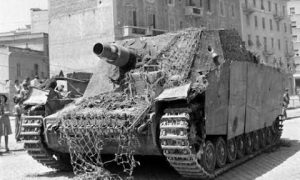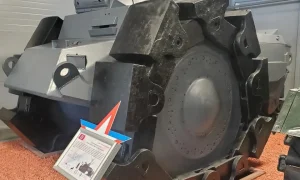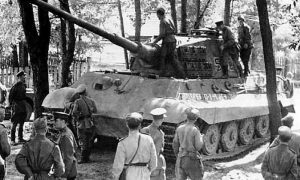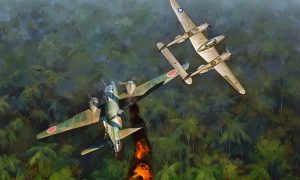FlaK 88mm, 18/36/37 anti-aircraft gun
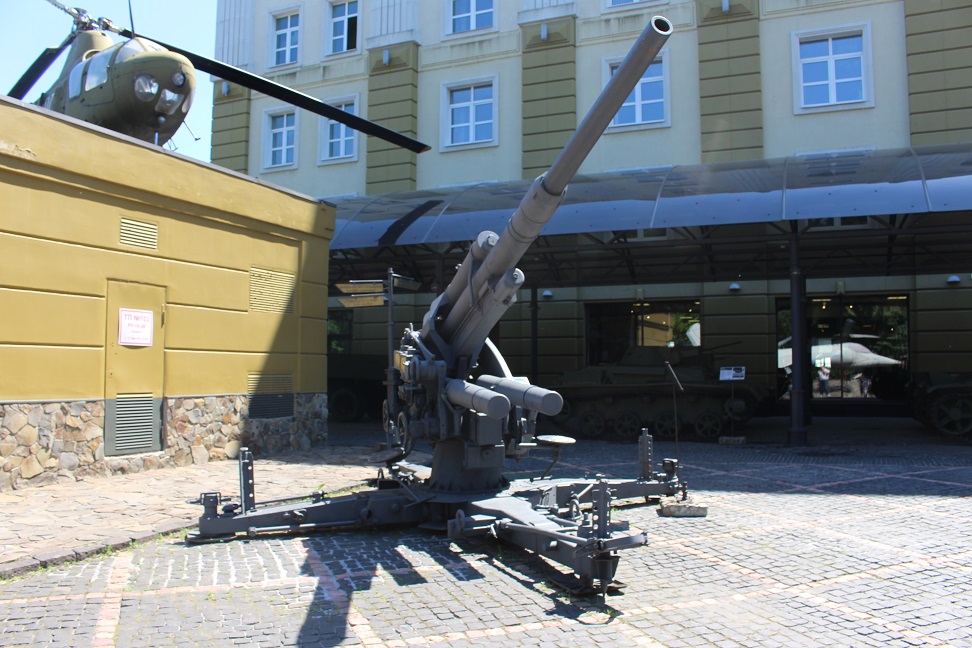
Flak 88 at Vadim Zhodorojni’s Technical Museum
8.8 cm FlaK 18/36/37(German 8.8-cm-Flugabwehrkanone 18/36/37, literally 8.8 cm anti-aircraft gun model 18/36/37 ), also known as ” eight-eight “(German Acht-acht)- German 88-mm anti-aircraft gun, which was in service from 1932 to 1945. One of the best anti-aircraft guns of World War II. It also served as a model for the creation of guns for the Tiger tanks PzKpfw VI. These guns were widely used as anti-tank and even field guns. Often these guns are called the most famous guns of the Second World War.
Flak 88 Creation History
According to the German Treaty of Versailles, it was forbidden to have in service and develop anti-aircraft artillery. But already in the 1920s, German engineers from the Krupp concern again began to develop such guns. In order to overcome the limitations of the Treaty of Versailles, all work on the manufacture of samples was carried out at the Swedish Bofors factories, with which Krupp had bilateral agreements.
By 1928, prototypes of anti-aircraft guns of 75 mm caliber with barrels of 52-55 calibers and 88 mm with a barrel of 56 calibers were ready. In 1930, anticipating the development of high-altitude bomber aircraft, German generals and designers decided to increase the caliber of the 75-mm m / 29 anti-aircraft gun proposed by them, jointly developed by Bofors and Krupp. The 105-mm unitary shot seemed too heavy for field conditions – the loader could not provide a high rate of fire. Therefore, we settled on an intermediate caliber of 88 mm. Since 1932, mass production of guns began at the Krupp plant in Essen. This is how the famous Acht-acht (8-8) appeared – from the German Acht-Komma-Acht Zentimeter – 8.8 centimeters – 88-mm Flak 18 anti-aircraft gun.
Its deliveries to the anti-aircraft units of the Wehrmacht, formed on the basis of seven motorized anti-aircraft batteries of the Reichswehr, began in 1933 under the designation “8.8-cm anti-aircraft gun 18”. The indication “18” in the name of the gun alluded to 1918 and was made for the purpose of disinformation: in order to show that Germany adhered to the terms of the Treaty of Versailles, which prohibited the development of anti-aircraft guns.
Flak 88 Design Description
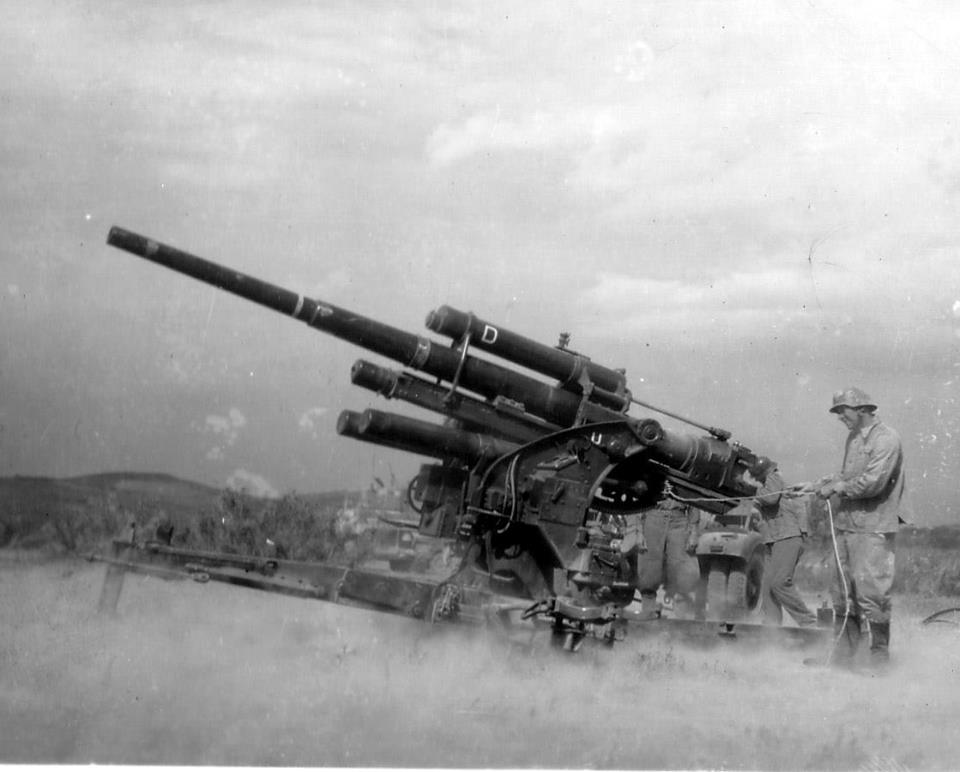
Flak88 Firing
Flak 18 had a monoblock barrel. The barrel of the Flak 36 gun consisted of a casing, a free tube and a breech. Such a constructive solution was determined by the fact that high initial projectile velocities, reaching 800-820 m / s, and a significant weight of the powder charge led to rapid wear (“heat”) of the barrel. Therefore, it was much cheaper to change the free pipe than the entire barrel. A semi -automatic horizontal-wedge-type bolt ensured the extraction of the spent cartridge case and the cocking of the mainspring due to the recoil energy, had a rate of fire of 15-20 rounds per minute. The recoil of the barrel was limited by the limiter. To return the gun to its original position, a pneumatic knurled over the barrel was used. Under the gun barrel, a spring balancing mechanism is mounted in two cylinders, which facilitates the vertical aiming of the gun. The basis of the gun carriage was a cross, in which the side beds, when moving to the stowed position, rose up, and the longitudinal beam played the role of a wagon.
The values of the fuse setting and the elevation and rotation angles necessary for firing at air targets were determined by the anti-aircraft fire control device and transmitted to the gun to the tube transmission device through a 108-core cable. The same information could be transmitted to the gunner by phone.
Modifications Flak 36/37
The Flak-36 gun appeared in 1935 and differed from the prototype in a simplified carriage design, an improved barrel, and a lower cost achieved by replacing all brass parts with steel ones. Due to the fact that the front and rear frames of this gun are interchangeable, two identical single-axle bogies were used for its transportation. Created a year later, the next modification – Flak-37 – had an improved fire control system. The performance characteristics of these modifications approximately correspond to the characteristics of the Flak-18.
First of all, serious measures were taken to reduce the time it took to deploy the cannon from traveling to combat position. A new mechanism for unloading the gun from derived carts was developed, and the possibility of firing at ground targets directly from the stowed position was also provided. To do this, only the side stops of the cruciform stand were lowered to the ground, the gun was leveled and stabilized with the help of steel piles driven into the ground through the holes in the stops. In addition, the wheelchairs tightened and blocked the brakes. The second important improvement in the design of the gun was the manufacture of the barrel from several elements, which made it possible to replace its worn-out fragments directly in the field. But the main drawback of the gun – its high silhouette, comparable in size to a tank, could not be eliminated. In 1940both modifications of the gun, as well as the Flak 18, were equipped with an armored shield designed to protect the gun crew from bullets and shrapnel.
Thus, Flak 36 was a universal gun that could be used to combat air and ground targets, while Flak 37 was created specifically as an anti-aircraft gun, permanently installed in batteries of four guns in fortified positions and carts for transportation were not completed at all. Most of the nodes of the guns arr. 18, 36 and 37 were interchangeable, for example, one could often see the barrel of a Flak 18 on a Flak 37 carriage. The guns were combined with a range finder, radar, Ubertransunger 37 data transmission system, which transmitted information about the direction of fire, the angle of elevation of the gun and the delay of shell burst.
An important advantage of these guns was the presence of an automatic cartridge case ejection mechanism, which allowed trained personnel to provide a rate of fire of up to 20 rounds per minute. But in order to load the guns with a 15-kilogram unitary cartridge every three seconds, 11 people were needed for each gun, of which four or five were exclusively engaged in the supply of ammunition. Creating such a large team in the field was far from an easy task, and getting the position and mittens of the loader – the one who put the projectile in the cannon lock – was a high honor and proof of qualification.
Manufacture and number of guns
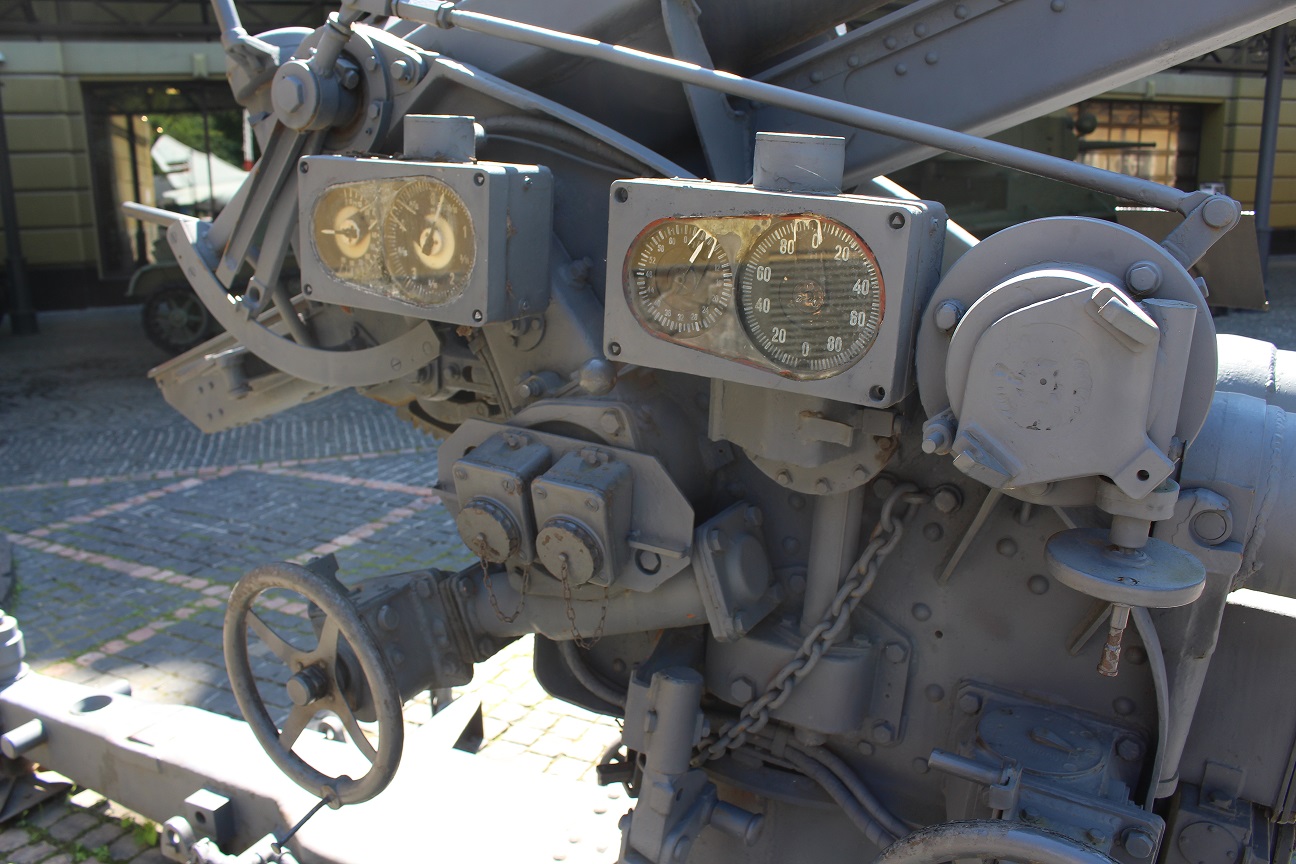
Flak 88 Controls
The Treaty of Versailles allowed the Germans to have only 168 obsolete 75-mm guns, in addition, Article 167 limited the number of shells for each gun to 1500 pieces. The rearmament of air defense, contrary to Versailles, three years before Adolf Hitler came to power, was planned by the leadership of the Weimar Republic. In 1930, the so-called Second Rearmament Plan was proposed, according to which the Reichswehr should acquire 792 heavy machine guns, 30 37-mm cannons, 24 75-mm cannons, 48 88-mm cannons, 4 105-mm cannons for air defense purposes in the coming years. Despite such a modest plan, due to lack of funding, it was only possible to implement it after the Nazis came to power .
In 1935, the revival of the armed forces began and a significant increase in their number. In 1933, 5,100 soldiers and officers served in the ranks of the air defense, and in 1937 already 47.5 thousand, and more than 70,000 in 1938. The production of cannons developed in the same way. In 1935, 27 million Reichsmarks were allocated for the production of all types of anti-aircraft guns, and in April of the same year, an additional 9 million Reichsmarks were allocated only for 88-mm guns. The entire budget of the air defense forces was 205.6 million Reichsmarks. For comparison, in 1930 the entire budget of the Reichswehr was 484 million Reichsmarks . In 1939, the cost of an 88 mm Flak 36 was 33,600 Reichsmarks .
The number of guns in the Wehrmacht as of April 1938 was 1984 88-mm guns and 2.7 million shells, as of September 1, 1939 – approximately 2167 88-mm guns and 5.541 million shells . With the outbreak of World War II, the need for these guns increased significantly, especially since they were very widely used not only in the air defense forces, but also in the ground forces. The dynamics of production and losses is shown in the table.
| Production and loss of 88 mm guns during the war, pcs. | ||||||||||
| Model | Before 1939 | 1939 | 1940 | 1941 | 1942 | 1943 | 1944 | 1945 | Total: | |
| Production | 18/36/37 | 2313 | 487 | 1131 | 1861 | 2822 | 4302 | 5714 | 1018 | 19648 |
| 37/41 | one | 5 | 6 | |||||||
| 41 | 6 | 54 | 122 | 273 | 75 | 530 | ||||
| Total | 2313 | 487 | 1132 | 1872 | 2876 | 4424 | 5987 | 1093 | 20184 | |
| Losses | 120 | 492 | 1776 | 2160 | 4560 | |||||
Despite the fact that the production of guns increased significantly during the war, their needs for troops, especially anti-aircraft artillery, were never fully satisfied. Ground forces first received 88-mm guns in 1941 (126 guns). In 1942, another 176 guns were received, in 1943 – 296, in 1944 – 549 and in 1945 – 23 installations. In August 1944, the Wehrmacht and Luftwaffe had 10,930 Flak 18, 36 and 37 guns, which were used on all fronts and in the air defense of the Reich. The Italians had a number of these guns under the name 88/56 S.A.
Flak 88 Characteristics and properties of ammunition
| 88 mm FlaK 18/36/37 anti-aircraft gun | |
| Caliber, mm | 88 |
| Rate of fire, rds / min | 15-20 |
| Barrel | |
| Barrel length, mm/klb | 4928/56 |
| Weight | |
| Weight in the stowed position, kg | 8200 |
| Weight in combat position, kg | 5000 |
| Dimensions in the stowed position | |
| Length, mm | 5500 |
| Width, mm | 1765 |
| Height, mm | 2100 |
| Firing Angles | |
| Angle ВН, deg | 85° |
| Angle GN, deg | 360° |
For firing, cartridge-loading shots with shells for various purposes were used. Fragmentation shells with a remote fuse were used against aircraft. The initial speed of such a projectile was 820 m / s, with a projectile weight of 9 kg, the explosive charge was 0.87 kg. The height reach of this projectile reached 10,600 m .
For 88 mm anti-aircraft guns mod. 18, 36, 37, as well as for self-propelled guns mod. 18 and 36 rounds are common.
The sleeve is solid drawn brass, index 6347, or seamless steel, brass plated, index 6347 St. Sleeve dimensions: length 570 mm, flange diameter 113.5 mm.
8.8cm Pzgr
Full name: Panzergranate
- Type of projectile: armor-piercing tracer
- Initial speed: 820 m/s
- Projectile weight: 9.5 kg
- Explosive: pressed TNT (117 g) with a detonator from a phlegmatized heating element (31 g)
- Fuze: Bd. Z.f.
- Shot weight: 15.3 kg
- Sleeve length: 570 mm
- Propelling charge : 2.50 kg nitrodiglycol tubular powder brand Digl.RP-8-(460.5.5 / 2.75)
- Capsule: percussion, model C/12 nA or C/12 nA St
8.8 cm Pzgr.39
Full name: Panzergranate 39
- Type of projectile: armor-piercing blunt-headed with a ballistic tip
- Initial speed: 790 m/s (800)
- Projectile weight: 10.2 kg (10.0)
- Explosive: 64 g, RDX phlegmatized
- Fuze: Bd.Z. 5127
- Shot weight: 16 kg
- Sleeve length: 570 mm
- Propelling charge : 2.50 kg Digl.RP-8-(460.5.5/2.75) nitrodiglycol tubular powder, 35 g potassium sulphate flash suppressor
- Capsule: percussion, model C/12 nA or C/12 nA St.
After the war, armor-piercing and HEAT rounds for the 88mm cannon were developed in Spain. Their characteristics are given in the table .
| Characteristics of armor-piercing shells for the 88-mm gun | ||
| projectile type | Armor penetration at 100 m | Armor penetration at 1500 m |
| Pzgr | 98 mm | 78 mm |
| Pzgr 39 | 128 mm | 97 mm |
| Pzgr 40 | 185 mm | 123 mm |
| HL Gr 39 | HEAT projectile | 90 mm up to 3000 m |
Organizational structure
88-mm guns were organizationally part of the Air Defense Forces. The ground forces(Heer)began to enter only in 1941. Four 88 mm guns formed a battery, which was considered heavy. To combat air targets, each battery was provided with an anti-aircraft artillery fire control device, which produced the necessary installations for firing.
There were two types of battalions in the air defense forces : heavy and light air defense battalion. 88-mm guns were part of only heavy air defense battalions. The regular strength of the heavy battalion was as follows:
- Three 88mm batteries (4 guns and 3 20mm machine guns each)
- One 37 mm battery (9 guns)
- One battery of 150 cm spotlights (9 spotlights)
- Six sound detectors
- Personnel: 143 soldiers and officers.
In the ground forces, 88-mm guns were also used in anti-tank units .
Flak 88 Combat use
War in Spain
In 1936, the Spanish Civil War broke out. On the battlefields, which became a training ground for the USSR and the Third Reich, new types of weapons were tested for the first time – the Messerschmitt Bf.109 fighter, the Junkers Ju 87 dive bomber, the 37-mm Pak 35/36 anti-tank gun and the 88-mm Flak 18 anti-aircraft gun.
The Condor Legion included several Flak 18 batteries. During the battles, these guns were successfully used not only against aircraft, but also against ground targets, primarily against tanks.
Taking into account the experience of fighting in Spain, armor-piercing and cumulative shells were developed for 88-mm guns. And the guns designed to interact with field troops are provided with a shield cover that protects the crew from small arms fire and fragments of shells and bombs
Flak 88 in the Second World War
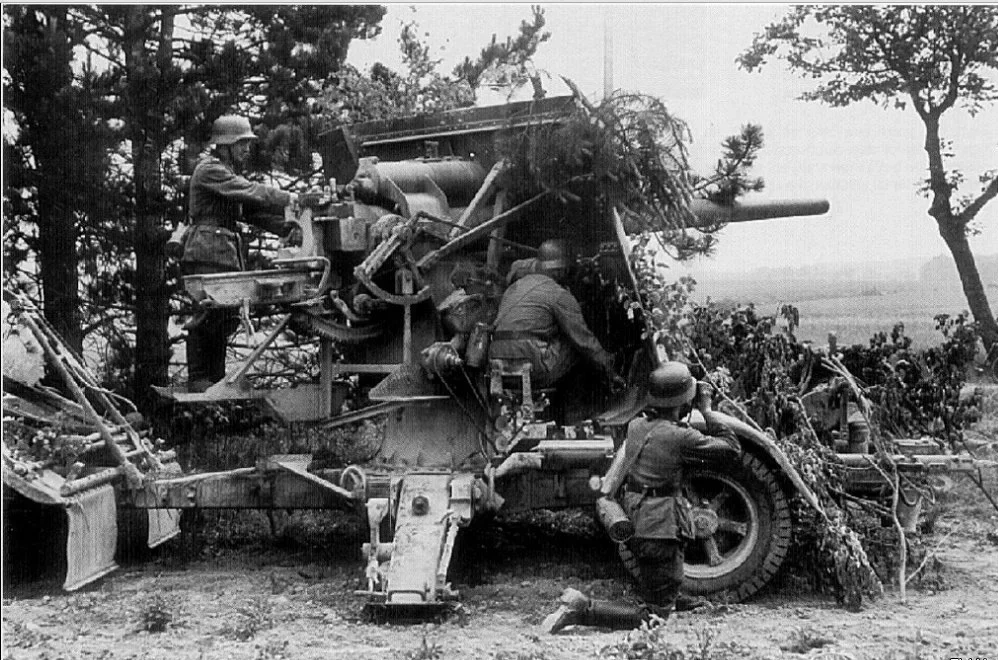
Flak88-Firing
88-mm guns were used on all fronts from the beginning to the very end of the war. Throughout the war, they repeatedly proved their effectiveness in the fight against enemy aircraft and armored vehicles.
During the first lightning campaigns of the Wehrmacht in Poland (1939) and France (1940), 88-mm guns were used mostly as anti-aircraft guns. The anti-aircraft regiment of Colonel Walter von Hippel performed especially well, which, while defending pontoon crossings across the Meuse, shot down 150 aircraft in just one day on May 14. This success contributed to the successful development of the offensive of Guderian’s tank corps. Colonel von Hippel was awarded the Knight’s Cross for this battle .
88-mm guns came in handy on May 21, when Rommel’s 7th Panzer Division was attacked by units of the British 50th Division and the 1st Army Tank Brigade, armed with Matilda medium tanks. The German anti-tank 37-mm guns could not cause significant damage to the British tanks, and only “eight-eight” stopped the British advance.
And yet, in these two campaigns, 88-mm guns took a limited part. This is primarily due to the transience of these campaigns, the rapid collapse of the Allied defenses, and the decisive actions of tanks and aircraft, which decided the fate of the battles.
Fighting in Africa
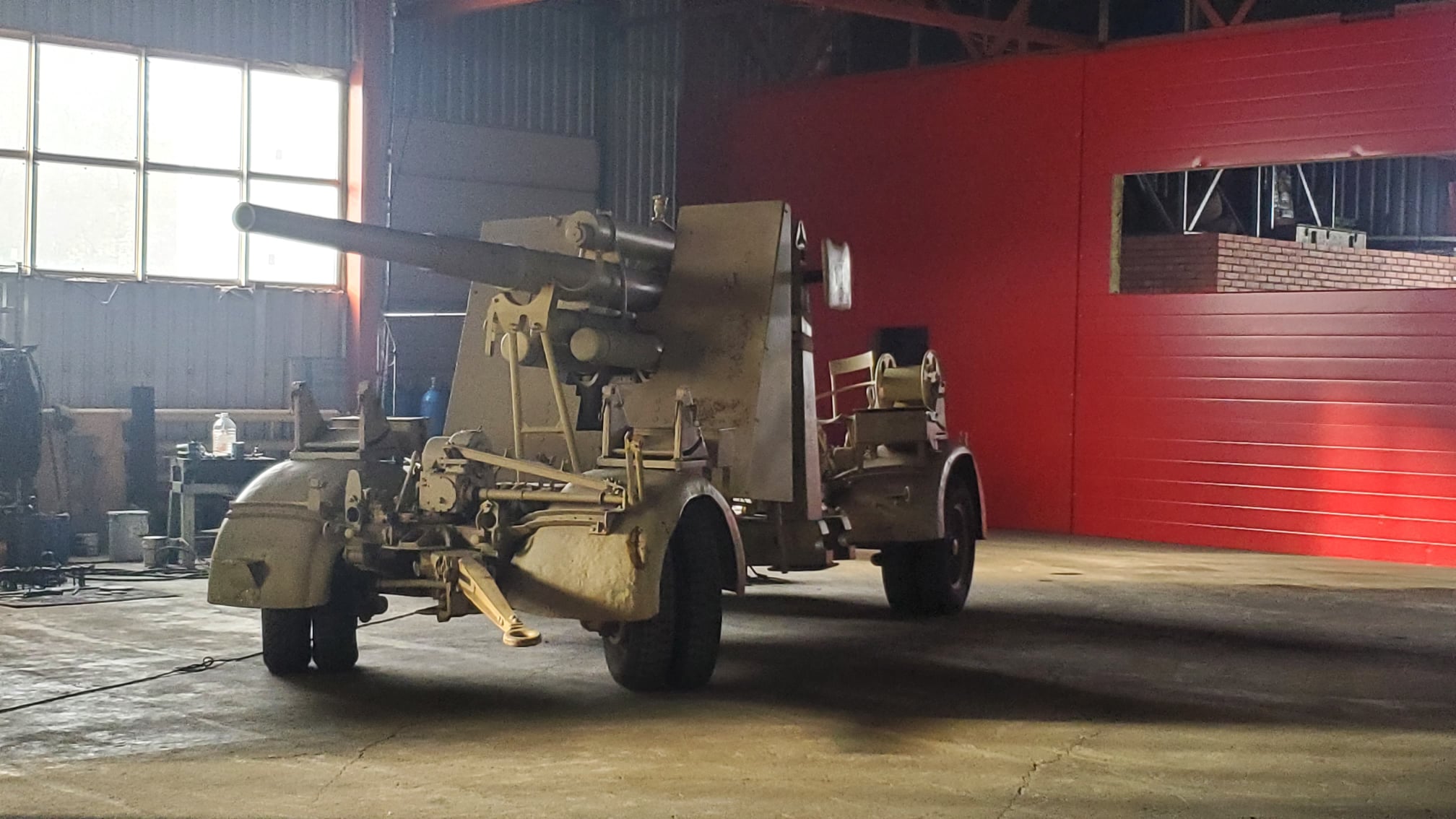
Flak88 In Desert camo With Carrier
Perhaps the most interesting and instructive is the experience of using 88-mm guns during the battles in the desert. From the very beginning to the end of the African campaign, the British army always had an advantage over the German and Italian troops in the number and quality of tanks. For example, in 1941, when Rommel’s troops arrived in Africa, they were armed only with 37 mm Pak 35/36 anti-tank guns and tanks PzKpfw II (20 mm gun), PzKpfw III (37 mm gun) and PzKpfw IV(75 mm gun) with a low muzzle velocity. The British at the same time had tanks: Matilda, Valentine, Crusader, Stuart, the first two of which were intended for direct infantry support, had powerful anti-shell armor for their time and were almost invulnerable to the Germans. Therefore, 88-mm guns turned out to be the only effective means for the German troops to fight enemy tanks.
At first, Rommel’s army had only 12 88-mm guns, but they had a very significant impact on the course of the battles. For example, during Operation Battleaxe, the British planned to strike the first blows on the hills of Halfaya and Hafrid, on each of which Rommel set traps (by burying batteries of 88-mm guns in the ground). The result of their use was the complete failure of the offensive in these areas. Here is what the English historian Liddell Hart writes:
It was already quite light when the Matilda tank battalion, which led the attack, began to overcome the last section separating it from the enemy. The first message from the commander of the tank battalion by radio telephone: “They are tearing my tanks to pieces” became the last report. In the tank trap that Rommel created by placing four 88-mm cannons near the pass, rightly called the “Hellfire Pass” by the British soldiers, only one of the 13 Matilda tanks survived.
In sectors of the front where there were no 88-mm guns, the British managed to break through the defenses.
Later, Rommel’s troops began to receive new 50 mm anti-tank guns, and later 75 mm, which strengthened the anti-tank defenses, but they could not completely replace the anti-aircraft guns.
Until the very fact of using anti-aircraft guns to fight tanks, the British command was skeptical about this possibility, and therefore the British could not predict Rommel’s next step: the use of anti-tank and 88-mm guns in the offensive. Before the attack, the Germans secretly pushed their guns to the front line and supported it with fire during a tank attack. At the same time, British tanks were struck from distances that were inaccessible to them, and seeing German tanks in front of them, the tankers believed that they had been hit by tanks. It seemed that their vehicles were worse, and the tankers were losing faith in the power of their own weapons, although this was not at all the case.
All batteries of 88-mm guns were motorized and could turn around very quickly in positions. In addition, the ability of the guns to fire directly from the carts significantly increased their mobility.
In 1942, the 88 Flak came in handy again for the Germans. The fact is that at this time the British army began to receive in large quantities new American tanks Grant and Sherman. Only 75 mm guns could fight them, which Rommel had few.
In the battle at Sidi Rezega, Rommel had only 19 German Pz.Kpfw.III Ausf.J tanks with a long-barreled 50-mm cannon and 48 88-mm cannons against 400 British Grant tanks. The advantage of the new American tanks was unconditional. On May 26, during their first appearance in battle, they caused panic in the ranks of the German troops. And again, only quickly deployed anti-tank guns and three “eight-eight” batteries stopped the offensive. On May 30, 1942, during the attacks of the encircled German African Corps, batteries of 88-mm guns, along with other anti-tank guns, repulsed the attacks of two British tank brigades, inflicting heavy losses on them and breaking their morale .
Samuel W. Mitcham, in Rommel’s Greatest Victory, describes the lethal effects of 88mm cannons:
… The 88 mm cannon sent its 21-pound projectile to a distance of 2 miles with exceptional accuracy. For example, in the battle of Sidi Omar in November 1941, a British tank regiment lost 48 out of 52 tanks. All of them were destroyed by 88 mm guns. None of the British tanks even managed to get close enough to fire on the German guns.
The historian of the 9th Royal Lancers writes: “A direct hit (an 88-mm cannon) was like hitting a huge sledgehammer on a tank. The projectile punched a neat round hole about 4 inches in diameter, a whirlwind of red-hot fragments burst into the tower. Such a hit usually meant death … Until the very end of the war, 88-mm guns remained our most dangerous enemy. “…
… General Nering reacted immediately. He shouted to Colonel Alvin Welz, commander of the 135th Motorized Anti-Aircraft Regiment: “Aircraft forward!” 16 deadly 88 mm anti-aircraft guns were quickly brought forward, and the regiment deployed in a line of about 1.5 miles, organizing a cross-fire system. The British tankers, having finished with the grenadiers, attacked the last line of defense just at the moment when Woltz completed its preparation. It quickly became clear that the “Grants” could not withstand the impact of 88-mm shells fired from a distance of 1200 yards. Soon 24 “Grants” were already burning, and the survivors hurried to retreat …
The skillful use and high efficiency of these guns led to the fact that the British completely lost heart. Here is what Major General F. Mellenthin, Deputy Chief of Staff of the Africa Tank Army, writes :
But there was neither strength nor pressure in the blows of the British, and usually a few shots from 88-mm cannons were enough to stop their tank attack.
Throughout the African campaign, batteries of 88-mm guns, despite their shortcomings, such as: a high and difficult to camouflage gun carriage, bulky and heavy gun weight, were the most effective tank destroyer.
Even during the last battles of the campaign in Tunisia, when the entire front was ruined and paralyzed by a lack of fuel, food and ammunition, a detachment of German troops armed with 88 mm guns held back the advance of the British 6th Armored Division for two days.
Heinz Werner Schmidt, in his book “With Rommel in the Desert” (Tsentrpoligraf 2004, p. 85), mentions a funny incident that took place during Operation Battleaxe :
“Several Englishmen were captured. I accidentally overheard the interrogation of a young guy, a tank driver. “I think,” the Englishman said, throwing an evil glance at an 88-millimeter gun standing nearby, “that it is dishonest to use anti-aircraft guns against tanks. A German artilleryman squatting next to him exclaimed indignantly: “Of course, it’s not fair, but is it fair to attack with tanks, whose armor can only be pierced by this gun!”
Eastern and Western Front
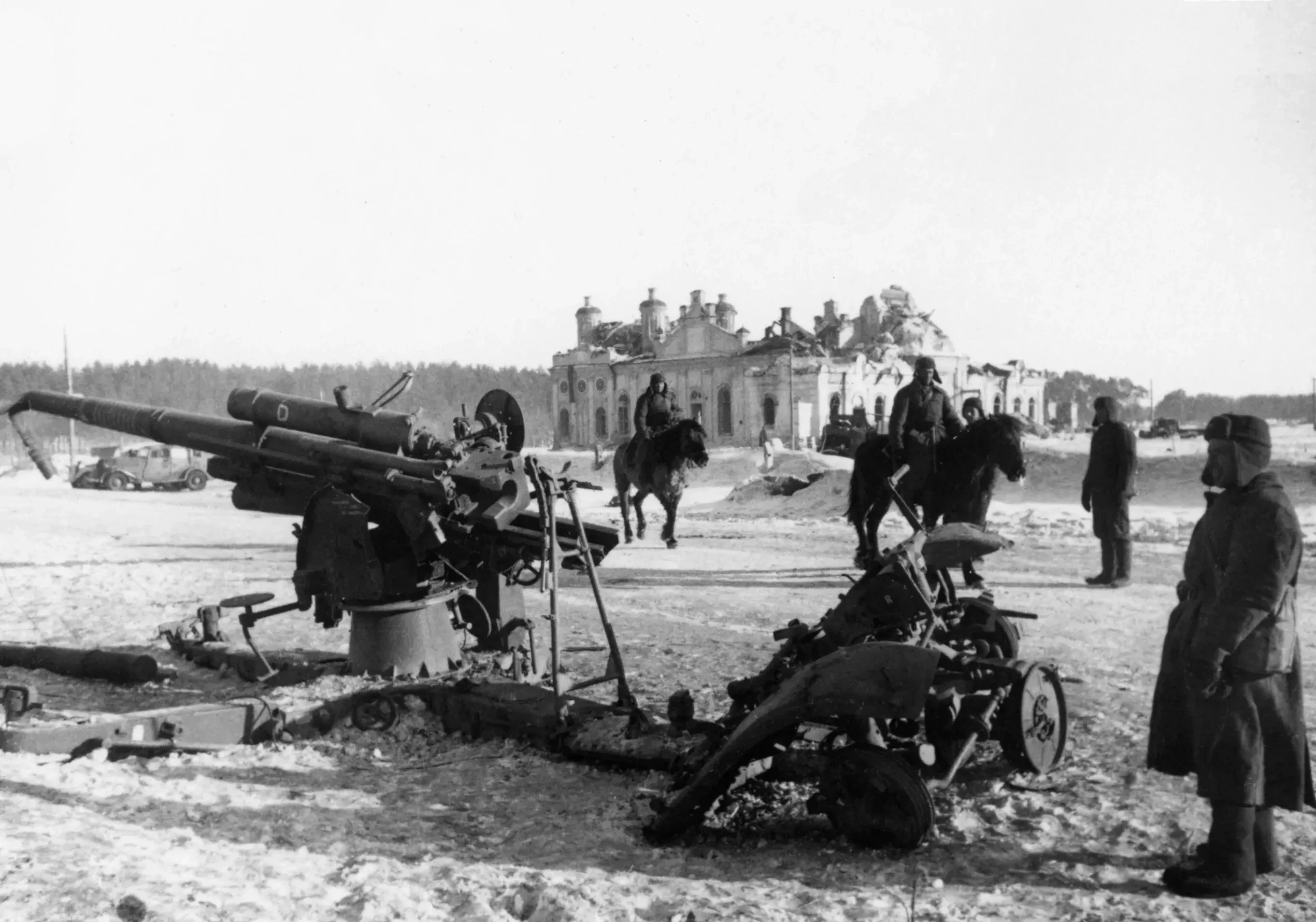
Destroyed Flak 88 on the Eastern Front
For 1941, the basis of the German anti-tank artillery was the 37 mm Pak 35/36 anti-tank gun. Only at the end of 1940, 50-mm Pak 38 anti-tank guns began to enter the troops, but on June 1, 1941 there were only 1047 of them. And the Wehrmacht received the first 15 75-mm Pak 40 anti-tank guns only in February 1942.
A similar picture was in the tank troops. The basis of the tank divisions were tanks: T-III modifications A-F, which were armed with a short-barreled 37-mm gun KwK 36; T-IV modifications A-F, with a short-barreled 75-mm gun KwK 37; and Czech-made PzKpfw 38(t) tanks with a 37 mm KwK 38(t) gun. New T-III tanks with a short-barreled 50-mm KwK 38 gun appeared in 1941, but as of February there were only 600 of them. Tanks T-III and T-IV with long-barreled guns 50 mm KwK 39 and 75 mm KwK 40 began to enter the troops only in the spring of 1942.
Therefore, when in 1941 the Germans met with Soviet tanks KV-1, KV-2 and T-34-76, the Wehrmacht was in a panic. The main anti-tank and tank gun of 37 mm caliber could hit T-34 tanks at a distance of only 300 meters, and KV tanks only from 100 meters. So, in one of the reports it was said that the calculation of the 37-mm gun achieved 23 hits in the same T-34 tank, and only when the projectile hit the base of the tower, the tank was put out of action. The new 50-mm guns could hit T-34 tanks from 1000 meters, and KV tanks from 500 meters, but these guns were few.
Given the above data, it can be seen that the 88-mm anti-aircraft gun, especially in 1941-1942, was almost the only effective means for the German troops to fight enemy tanks. She could hit all types of Soviet tanks throughout the war. Only IS-2 tanks could resist her fire, but at a distance of no less than 1500 meters.
The 88 mm gun was used on all fronts, both as an anti-aircraft gun and as an anti-tank gun. In addition, since 1941, she began to enter the anti-tank units. The significance of this cannon is clearly seen from the words of the German tanker Otto Carius, who writes in his book “Tigers in the Mud”:
The only way out left the 88-mm anti-aircraft gun. With its help, it was possible to operate effectively even against this new Russian tank. Therefore, we began to treat anti-aircraft gunners with the highest respect, who until then got only condescending smiles.
And here are the words of the Soviet tankman Ion Lazarevich Degen, lieutenant of the tank troops (book by A. V. Drabkin “I fought on the T-34”):
For all its strengths, the T-34 tank was quite vulnerable, and in the “competition between the projectile and the tank” we were often unlucky. The 88-mm German gun pierced through the frontal armor of the T-34.
The use of 88-mm guns was widespread, with their versatility, they were indispensable helpers of troops in battle. And high efficiency and skillful use leveled such shortcomings as a high silhouette and heavy weight.
Since 1942, the troops began to receive 50-mm and 75-mm anti-tank guns, Panzer 3, Panzer 4 tanks with long-barreled guns, later Tiger tanks with an 88-mm gun, and then anti-tank defense no longer became to such an extent depend on 88 mm anti-aircraft guns. But still, these guns always proved their effectiveness, remaining the most formidable enemy of enemy tanks until the very end of the war.
Below is a table of characteristics of the main tanks of the USSR and allies that were used during the war. From the table we can see that even the most advanced tank models: T-34-85, IS-1, Sherman, Pershing, Komet could be hit by 88-mm cannons at distances of 1.5 km (at this distance, an 88-mm cannon pierced armor up to 120 mm).
| Characteristics of the armor protection of the main tanks of the Allies and the USSR during the Second World War
(in parentheses – reduced armor thickness) |
||||
| Name of the tank | Country | Armament | Frontal armor, mm | Tower armor, mm |
| Matilda Mk II | Great Britain | 40 mm gun | 78 | 78 |
| Valentine Mk III | Great Britain | 40 mm gun | 60 | 65 |
| Churchill Mk IV | Great Britain | 75 mm gun | 102-152 | 102-152 |
| Crusader Mk VI | Great Britain | 57 mm gun | 51 | 51 |
| Cromwell Mk VII | Great Britain | 75 mm gun | 64 | 76 |
| Komet A 34 | Great Britain | 77 mm gun | 76 | 102 |
| T-60 | USSR | 20 mm gun | 35 (70) | 25 |
| BT-7 | USSR | 45 mm gun | twenty | fifteen |
| KV-1 | USSR | 76 mm gun | 75 (87) | 75/95 (80) |
| KV-2 | USSR | 152 mm gun | 75 (87) | 75 |
| T-34 | USSR | 76 mm gun | 45 (90) | 52 |
| T-34-85 | USSR | 85 mm gun | 45 (90) | 90 |
| IS-1 | USSR | 85 mm gun | 120 (139) | 100 |
| IS-2 | USSR | 122 mm gun | 120 (139/240) | 100 |
| Stuart M3 | USA | 37 mm gun | 38 | 32-38 |
| Grant/Lee M3 | USA | 75 mm gun | 51 (63) | 38-51 |
| Sherman M4 | USA | 75 mm gun | 51 (88) | 51-89 |
| Pershing M26 | USA | 90 mm gun | 102 (150) | 76-114 |
These guns were also installed on the Siebel catamaran ferries, which fought, in particular, on Lake Ladoga.
Flak 88 in Application in the Air Defense Forces
88-mm anti-aircraft guns were used to defend positions in the rear, protect cities, warehouses, industrial enterprises, railway stations, bridges and other objects from high-altitude air raids. Also, these guns until 1942-1943. were part of the garrisons of the anti-aircraft towers of the Luftwaffe, where they made up heavy anti-aircraft artillery, later they were replaced by 105-mm and 128-mm anti-aircraft guns .
This cannon was usually used by batteries of four cannons, which were part of the heavy air defense battalions. To control fire, any number of guns could be combined into a battery with attachment to a command post. Such a center included a trailer with a generator, a trailer with a searchlight and targeting devices. All guns of the battery were connected to such a command center.
When protecting an object during night raids by allied aviation, the search and “capture” of the target with a searchlight were first carried out. The guidance installation operator was then supposed to visually track the targets. The devices built into the tracking installation automatically gave out data on the target’s height and angle above the horizon directly to the guidance devices of each anti-aircraft gun. Each of the devices (height and angle of the target) was duplicated. Data from the command center was displayed on small dials. All that remained for the gunner of each gun to do was to set exactly the same values on the large dials, that is, aim his own gun at the target. Thus, the firepower of the entire battery could be concentrated on one target, which created a dense barrage. The anti-aircraft gun was capable of firing 12-15 rounds per minute, the gun projectile could cause fatal damage to the aircraft, even exploding at a distance of 15 meters from the target.
Also, for aiming anti-aircraft guns at aircraft that flew at high altitude, data from radar instruments were used. The accuracy of the instruments was ± 100 m, for the Wurzburg radar the accuracy of determining the location of the target was ± 15 meters, therefore, a certain firing sector was set for guidance, on which the entire battery (or several batteries) fired. With this method of firing, the waste of ammunition was very large: 5000-8000 shells per aircraft. A very big disadvantage of German anti-aircraft guns was the lack of proximity fuses, which could greatly increase the effectiveness of the fire, which could radically affect the outcome of the war in the air .
An interesting fact is that sometimes the total cost of ammunition used to destroy an aircraft exceeded the cost of a downed aircraft, but it was believed that the damage that this aircraft could cause exceeded the cost of shells.
Here are the words of the English pilot Johnson James Edgar, from the book “The Best English Ace”:
Now the yellow sandy shore is clearly visible, a little further – sand dunes and hard bushes. Having carefully disguised themselves among the hills, well-trained gunners of terrible 88-mm anti-aircraft guns are already waiting for us. We’re breaking through the anti-aircraft curtain over Le Touquet. Black gloomy flowers bloom in the sky, red-hot steel fragments whistle around. Several red spots of signal shells appear, which will indicate our position to the Messerschmitts. We turn and turn to jump over the wall of gaps. From his relatively safe position at the top, Stan watches our twitching and lets out a few scathing remarks over the radio. The tension is easing.
The 88 mm anti-aircraft gun was a successful gun that harmoniously combined high range, fast pace and accuracy of fire with relatively light weight and simplicity. She not only was not inferior to her counterparts, which were armed with enemy troops (see table), but also gained almost legendary fame for herself as an effective universal gun, equally formidable for enemy aircraft and tanks.
Comparative characteristics of medium-caliber anti-aircraft artillery
| Comparative characteristics of medium-caliber anti-aircraft artillery of the Second World War | ||||||||||||||
| Country | Model | Release,
PCS |
Caliber, mm | barrel length,
club |
Initial speed, m/s | Projectile weight, kg | Effective height reach,
m |
Maximum height reach
m |
Firing range, m | Rate of fire, rds / min | Firing angles vertical, degrees | corners
shelling horizontally, degrees |
Mass in combat position,
kg |
Mass in the stowed position,
kg |
| Great Britain | QF 3.7’AA
|
94 | fifty | 792 | 12.75 | 9754 | 10 600 | 18 800 | 15-17 | 0+85 | 360 | 9317 | 9317 | |
| USA | 3-in AAG; M3
rus. |
807 | 76.2 | fifty | 730 | 6.8 | 6400 | 7900 | 13 400 | 25 | -1 +80 | 360 | 7620 | |
| USA | 90mm M1A1 and M2 | 90.3 | 53 | 823 | 10.61 | 10 600 | 12 000 | 17 823 | 17 | -5 +80 | 360 | 14 651 | 8618 | |
| Italy | Cannone da 75/46 modello 34
rus. |
318 | 75 | 46 | 750 | 6.5 | 8300 | 13 000 | 20-25 | -2 +89 | 360 | 3380 | 4405 | |
| Italy | Cannone da 90/53 modello 39 | 660 | 90 | 53 | 850 | 10.3 | 12 000 | 17 400 | twenty | -2 +85 | 360 | 6240 | 8950 | |
| Nazi Germany | Flak 36 | 13 726 | 88 | 56 | 790 | 9.2 | 8000 | 10 600 | 14 860 | fifteen | -3 +85 | 360 | 5000 | 7400 |
| Nazi Germany | Flak 41 | 556 | 88 | 71 | 1000 | 9.4 | 10 500 | 14 700 | 19 800 | 20-25 | -3 +89 | 360 | 8000 | 11 200 |
| USSR | 3-K; 76mm ZP arr. 1931 | 3821 | 76 | 55 | 815 | 6.5 | 8500 | 14 600 | fifteen | -3 +82 | 360 | 3750 | 4970 | |
| USSR | 51-K; 76mm ZP arr. 1938 | 960 | 76 | 55 | 815 | 6.5 | 9500 | 14 600 | fifteen | -3 +82 | 360 | 4300 | 4300 | |
| USSR | 52-K; 85mm ZP arr. 1939 | 14 422 | 85 | 55 | 800 | 9.2 | 10 500 | 15 650 | twenty | -3 +82 | 360 | 4500 | 4500 | |
| France | M-24 | 75 | fifty | 850 | 5.93 | 9000 | 14 100 | 15-20 | 0+85 | 360 | 2950 | |||
| Czech | PLvz. 37 | 75 | 48 | 775 | 5.5 | 9200 | 14 600 | 12 | 0+85 | 360 | 2800 | 4150 | ||
| Japan | Army Type 88 | 2000 | 75 | 44 | 720 | 6.52 | 725 | 9100 | 13 800 | 15-20 | -7 +85 | 360 | 2450 | 2740 |
| Japan | Army Type 99
rus. |
<1000 | 88 | 45 | 807 | 9-10 | 10 240 | 15 700 | fifteen | -11 +80 | 360 | 6650 | ||
88 Family of Guns
- 88mm Flak 18 – new semi-automatic shutter, high muzzle rate. Used on the Sonderanhänger 201 sidecar. Weight 7000 kg, rate of fire 15-20 rounds per minute. Later, the gun is equipped with a shield for protection against ground targets, and armor-piercing shells. A Krupp product .
- 88 mm Flak 36 – used on the Sonderanhänger 202 sidecar, which provided greater speed and also allowed firing from a cart. Later, the gun was equipped with a shield for protection against ground targets, and armor-piercing shells. Krupp product.
- 8.8 cm KwK 36 : – the main gun of the PzKpfw VI tank. Despite the resemblance to the 88mm Flak 36, some sources refer to it as a parallel offshoot with very similar performance, rather than a derivative of the Flak 36 .
- The 88mm Flak 37 is an updated version of the Flak 36, with the main difference being an improved data transmission and fire control system. Krupp product.
Flak 88 In Foreign Service
- Nazi Germany
- GDR
- Great Britain
- Finland
- Yugoslavia
- USA
- USSR – captured guns were used during the Great Patriotic War
- North Korea – captured guns captured by the USSR during the Great Patriotic War and transferred to the KPA, were used during the Korean War against American aircraft









